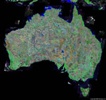Interesting interview with Jim Watson, former President of the Royal Society of NZ on Kathryn Ryan’s Nine to Noon programme this morning (podcast here, but only for a week). Watson, the founder scientist of Genesis Research & Development discusses the new Biojoule project being established at Taupo. A species of willow (not the cricket bat kind) will be grown and harvested to produce ethanol as a biofuel, and lignin, a biological chemical alternative to hydrocarbons from fossil fuel as a feedstock for plastics. Home grown technology in every sense of the word.
Author: Gareth
The roof’s melting…
Wetter and drier: we did it
The new Nature paper that prompted yesterday’s post on rainfall intensity is covered in detail by the BBC and New Scientist. Rainfall patterns around the globe are shown to be changing in response to increasing greenhouse gases, in line with model predictions. From New Scientist:
Tropical regions north of the equator, including such areas as the Sahel in Africa which borders the Sahara desert, have already begun to get even drier and will continue to do so, the data show. Regions in the far north, including Canada, Northern Europe and Russia, will get wetter, as will the southern tropics.
The magazine also quotes the paper’s lead author, Francis Zwiers of the Canadian Centre for Climate Modelling and Analysis in Toronto, on changes in rainfall intensity:
Zwiers says an important message from the combined models is that they consistently show that, for all regions, there will be a significant increase in extremes of precipitation – both floods and droughts. Thus, even desert areas that will undergo serious drying could simultaneously suffer greater risks of flash flooding. “More or less uniformly across all the models, these extreme events will become more intense just about everywhere,” he says.
Time to reassess flood risks in NZ, perhaps.
Wet times in Blighty, but “Med melts
Howard’s carbon conversion
 There’s an Australian federal election on the way, and – bless his cotton socks – John Howard has discovered there are votes in carbon policy. Over the last few days Howard has announced a national cap and trade programme for greenhouse gases as part of a new A$627 million climate change initiative, coupled with subsidies for solar hot water systems in schools, and an A$1,000 rebate for domestic installations. The carbon trading mechanism will not begin until 2011, covers only 55% of Australian emissions, and the administration has not announced how big the cap will be. Unsurprisingly, this has been criticised by environmental campaigners, as New Scientist reports:
There’s an Australian federal election on the way, and – bless his cotton socks – John Howard has discovered there are votes in carbon policy. Over the last few days Howard has announced a national cap and trade programme for greenhouse gases as part of a new A$627 million climate change initiative, coupled with subsidies for solar hot water systems in schools, and an A$1,000 rebate for domestic installations. The carbon trading mechanism will not begin until 2011, covers only 55% of Australian emissions, and the administration has not announced how big the cap will be. Unsurprisingly, this has been criticised by environmental campaigners, as New Scientist reports:
Caroline Fitzpatrick, of Greenpeace Australia accuses Howard of yielding to pressure from another group – Australia’s powerful coal industry – by announcing what amounts to a delaying tactic in carbon trading, rather than an effective new carbon-reduction scheme.
No doubt NZ’s Greenhouse Policy Coalition will renew its calls for the government on this side of the Tasman to match Howard’s cautious approach. Meanwhile, the Australia Institute has released a paper (press release, full paper [both PDF]), that calculates Australia’s emissions budget for the 21st century based on a “contract and converge


